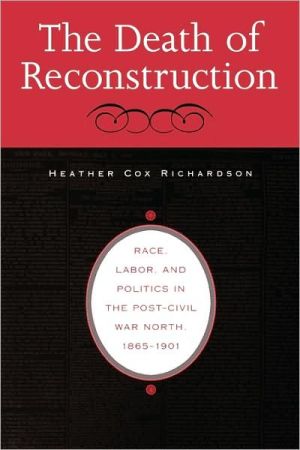

 |

|

The average rating for The death of Reconstruction based on 2 reviews is 4.5 stars.
Review # 1 was written on 2013-05-23 00:00:00 Marc Skinner Marc SkinnerHeather Cox Richardson’s 2001 work The Death of Reconstruction builds on Foner’s explorations of northern Free Labor ideology, seeking to elevate it as the pre-eminent factor in the demise of Reconstruction. “Symbolically as well as practically, in 1877 President Rutherford B. Hayes stopped using U.S. troops to protect southern freedmen,” Cox noted. “Instead, Hayes turned the military against workers engaged in America’s first national strike,” the Great Railroad Strike and the beginning, some feared, of a new civil war between labor and capital. The observation goes to the heart of Richardson’s theme – how Northern class conflict became the prism through which the conflict over Reconstruction in the South was perceived, to the detriment of federal support for the rights of freedmen. While other scholars had fallen back on somewhat vague explanations for the withdrawal of Northern support such as weariness or racism, Richardson had doubts; “had whites reacted to freedpeople solely on the basis of racism,” for example, “they should have discriminated against both poor and prosperous African-Americans alike, and their attitudes should have been unaffected by specific events or pieces of legislation. This was not the case.” Attempting to understand the place of Reconstruction in the Northern minds, Richardson examined changing attitudes expressed through print media and especially the newspapers which served as the primary mobilizers of partisan politics. She found that “when acting as Northerners expected free laborers to, ex-slaves enjoyed great support. In the years after the Civil War, though, as workers who believed in a conflict between labor and capital challenged the prevailing concept of America’s unique political economy, many interpreted the demands of the ex-slaves for land, social services, and civil rights as part of an attempt to subvert the American way.“ |
Review # 2 was written on 2020-12-27 00:00:00 Seong Kang Seong Kang"By 1880, Northern Republicans and Democrats shared a belief that there were two sorts of African-Americans, paralleling the two types of American worker. ... Prosperous African-Americans represented the traditional worker who rose through hard work by accumulating wealth. Other freedpeople represented the disaffected worker who believed in a societal conflict between labor and capital and who planned to advance by dominating the government and using it to confiscate wealth. In the 1880s and 1890s, Northerners who did not identify with a labor interest joined together to eliminate from power the disaffected African-Americans who seemed to threaten the core values of American society." (183) "There was a logical connection between the disfranchisement and the Progressive movement. Having removed from political power those who represented the use of government in the service of disaffected laborers, Americans could now entertain ideas of a government that worked to ameliorate the abuses of the industrial system without fearing the triumph of socialism." (244) |
CAN'T FIND WHAT YOU'RE LOOKING FOR? CLICK HERE!!!